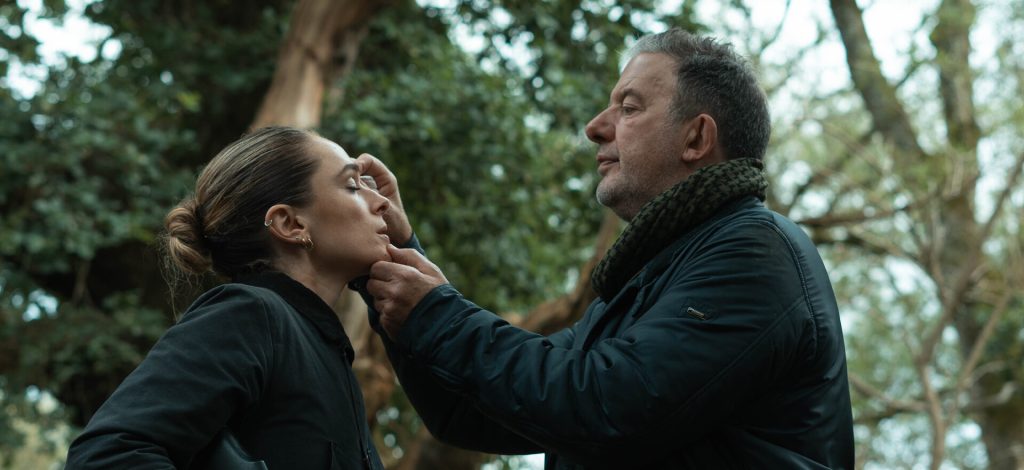Tension builds slowly, but once it takes hold, Snare never lets go. Director Sam Blakeney Edwards delivers a chilling and visually rich short film about a fractured family that discovers they are not the only hunters in the woods.

The film opens with a haunting image—a rabbit caught in a snare, struggling helplessly before succumbing to its fate. It is a grim and effective beginning that sets the tone for what follows. This is a story about control, cycles of violence, and the wrath of the natural world. Coming in at under twenty minutes, the short makes the most of its runtime, exploring guilt, familial tension, and supernatural punishment deep within the forest.
At the heart of the story is a strained family dynamic. Adrian, portrayed by Jay Villiers, is a stern father who exerts tight control over his children. His son James, played with quiet emotion by Kit Clarke, is more compassionate and clearly uncomfortable with the hunting trip he has been dragged into. His reluctance creates tension, particularly with his sister Harriet, played by Phoebe Sparrow. Harriet shares her father’s practical mindset and seems more comfortable with the violence of the hunt. Yet despite their differences, the trio remains bonded by blood and unresolved history.
As the family stalks deer through the woods, James begins to hear eerie sounds that pull him away from the others. The sound design in this section is a highlight, with creaking branches, the whisper of wind through trees, and unsettling tones that build an immersive and ominous soundscape. Sound supervisor George Castle and re-recording mixer James Benn deserve credit for crafting a deeply atmospheric audio experience that enhances the sense of dread.
James soon encounters a mysterious figure camouflaged in foliage and mud. The creature appears to be an extension of the forest itself, both ancient and sentient. When James is captured by this supernatural force, he becomes a tool for nature’s revenge, possessed and sent back to confront his own family. The story shifts at this point from a quiet folk horror into something more direct and confrontational. While the tonal shift may not resonate with all viewers, it opens up the film to moments of raw terror and emotional intensity.

Visually, Snare is stunning. Cinematographer Aaron Medway captures both the beauty and menace of the forest with exceptional clarity. Wide shots showcase the depth of the environment, while tighter compositions bring a claustrophobic energy that makes the woods feel alive. The colors are rich and natural, and colorist Matt Stevenson ensures a consistent tone that never distracts from the story. The visual effects team, supervised by Benedict Jewer, supports the narrative with organic and grounded work. From the creature design by Josie Mullins and Rebecca Birch to the subtle environmental distortions, every effect serves the mood and worldbuilding.
Composer Ben Pearson’s score further elevates the film. His music does not overpower but instead simmers underneath, building suspense and occasionally spiking into sharp cues during moments of horror. Editor Phil Whitehead keeps the pacing tight and deliberate, never rushing but also never allowing the tension to stall. Each scene flows logically to the next, and even when the story takes its supernatural turn, the momentum holds strong.
There is also strong emotional depth in the performances. Jay Villiers brings nuance to Adrian, making him more than just a hard-nosed authoritarian. His frustration with James masks a deep-seated vulnerability and fear. Clarke gives James a delicate balance of fear, empathy, and confusion, while Sparrow’s Harriet brings strength without losing her humanity. These dynamics give the film a weight that makes the horror more affecting.
Snare explores themes of dominance, familial legacy, and what happens when mankind assumes power over nature. In this case, nature responds not passively but with intent. The forest becomes a character of its own, watching, judging, and eventually acting. The imagery of roots and branches as tools of punishment is both poetic and frightening. It is nature correcting a moral imbalance in its own brutal way.

There are moments when the film leans into more traditional horror tropes, especially as James becomes an agent of supernatural force. Some viewers may prefer the ambiguity of the first half, where the horror is hinted at rather than made literal. But for others, the escalation offers catharsis and resolution to the themes of guilt and survival.
Snare is a sharply crafted short that blends folk horror with character-driven drama. With clear inspiration from nature-based horror and a confident directorial voice, it leaves a strong impression. Sam Blakeney Edwards has assembled a talented team, including producer Louis Taylor Baggs and a skilled crew across sound, effects, and cinematography. Their collective work results in a short film that is as polished as it is powerful.
Whether you come for the atmosphere, the strong performances, or the themes of supernatural revenge, Snare delivers. It captures something primal in its storytelling, reminding us that even in silence, nature is never still.
